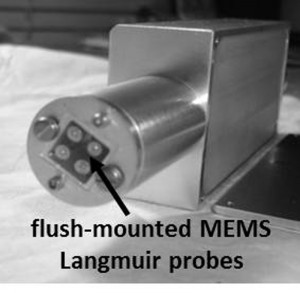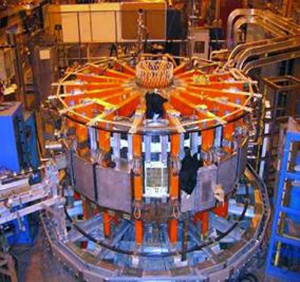Flush-mounted MEMS Langmuir Probe Arrays for HF-S Band Plasma-sensing
Arrays of MEMS Langmuir probes that are flush-mountable (Figure 1) can serve as a sensorial skin on a spacecraft for fine spatial and temporal resolution of plasma phenomena. The technology can also provide diagnostics for other applications such as tokamaks and nanosatellite scientific payloads [1] . The benefits are innumerable for deeper understanding of plasma physics, which is in great need of these microprobes [2] . For instance, multiplexed microprobes that are flush-mounted on all the faces of a 3-D “tip” can allow for simultaneous capture of a detailed “whole picture” of plasma behavior in different axes at a given timescale. In addition, two or more different sensory configurations, e.g., single-, double-, triple-probe methods, etc., can be adapted into the same flat die, profiting at the same time from their individual data acquisition strengths. Protruded probes cannot offer these advantages. Another area of deployment is in the observation of electron phase-space holes, self-consistent nonlinear plasma structures that are formed from strong current- or beam-driven turbulence and found in magnetic reconnection regions, which are magnetic field topology modifiers responsible for the explosive release of magnetic energy in magnetospheric storms, solar flares, and laboratory plasmas [3] . Fast micro-Langmuir probes that work at high frequencies are indispensable for studying these plasma fluctuations. We developed a system of flush-mounted MEMS Langmuir probes and apparatus with fast timescale; i.e., shorter time compared to the timescale of reconnection events in the Versatile Toroidal Facility at MIT (Figure 2); and wide bandwidth extending across regions of magnetosphere-photosphere, i.e., considering both electron and ion plasma frequencies associated with these regions.
- Figure 1: A 10-mm-wide die with total of four individual MEMS Langmuir probes flush-mounted on a probe shaft.
- Figure 2: Versatile Toroidal Facility at MIT. Magnetic reconnection experiments are conducted in the device.
- E. S. Field, “Batch-fabricated planar arrays of MEMS Langmuir probes for spacecraft reentry plasma diagnostics and nanosatellite scientific payloads,” Master’s thesis, Massachusetts Institute of Technology, Cambridge, 2011. [↩]
- P. Pribyl, W. Gekelman, M. Nakamoto, E. Lawrence, F. Chiang, J. Stillman, J. Judy, N. Katz, P. Kintner, and P. Niknejadi, “Debye size microprobes for electric field measurements in laboratory plasmas,” Review of Scientific Instruments, vol. 77, no. 073504, pp. 1-8, July 2006. [↩]
- W. Fox, M. Porkolab, J. Egedal, N. Katz, and A. Le, “Observations of electron phase-space holes driven during magnetic reconnection in a laboratory plasma,” Physics of Plasmas, vol. 19, no. 032118, pp. 1-12, Mar. 2012. [↩]

